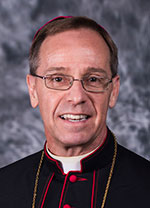Christ the Cornerstone
We believe that death is not the end of life, but a new beginning

“Christ will change our lowly body to conform with his glorified body by the power that enables him also to bring all things into subjection to himself” (Phil 3:21).
The Gospel reading for the Second Sunday of Lent (Lk 9:28b–36) provides us with a rare glimpse into life after death. We know very little about what happens to us immediately following our death, but one of the most consistent images used in sacred Scripture and in the testimony of those who believe they have experienced death briefly and then returned to life is of an extremely bright light.
One way or another, life after death is frequently seen to be luminous, a more revealing experience than “ordinary” experiences. We Christians believe that life as we know it now pales by comparison to eternal life as experienced by those who are united with Christ in heaven. Whereas our earthly existence is blurred and darkened by the realities of sin and suffering, the life to which we are called is made infinitely brighter by the joy and peace experienced by all the saints.
In the story of the transfiguration, St. Luke tells us that Jesus’ “face changed in appearance and his clothing became dazzling white” (Lk 9:29). We’re also told that the two figures who appeared with him, Moses and Elijah, “appeared in glory” (Lk 9:31), which means that they were resplendent with light and beauty.
Why did Jesus display his glory to Peter, James and John at this particular moment in his journey toward his passion and death? Was he calling them out of their comfort zones, as Pope Francis would say, in order to help them see that something extraordinary was happening through him?
Peter’s reaction is characteristically bold and impulsive. He wants to build three shrines to forever mark the place where Jesus was transfigured alongside these two giants of the Old Testament, Moses and Elijah. St. Luke tells us that Peter had no idea what he was proposing. The time was not right. First, Jesus had to endure great suffering and death. For him, as for us, the road to glory can only be the way of the cross.
After his resurrection, the Gospels tell us, Jesus’ appearance was changed. Often his disciples did not recognize him until he performed some action or sign that revealed to them his identity. Mary Magdalen thought he was a gardener. The disciples on the road to Emmaus thought he was just another traveler. Until he showed them the nail marks on his hands and feet, the disciples who were hiding behind locked doors did not know him.
The paradox of the risen Lord’s appearance is that he was both the same man and yet different. His body was the same, but after the resurrection it was glorified—enlightened, illuminated and resplendent, not necessarily “dazzling white” in its outward appearance, but definitely changed inwardly to reflect his dramatically changed circumstances.
In the second reading next Sunday
(Phil 3:17-4:1), St. Paul tells us that what the Apostles experienced immediately after his resurrection is our destiny as faithful disciples. “Our citizenship is in heaven,” St. Paul writes, “and from it we also await a savior, the Lord Jesus Christ. He will change our lowly body to conform with his glorified body by the power that enables him also to bring all things into subjection to himself” (Phil 3:20-21).
This is why we proclaim our faith in the resurrection of the body. It’s also why we believe in the communion of saints—all the members of Christ’s body, living and deceased, who will be united in glory on the last day.
Our Lenten journey toward Easter is a sacramental sign of the journey to heaven that all of us are called to make over the course of our lifetime. We undergo the Lenten sacrifices of prayer, fasting and almsgiving in order to prepare for the joy of Easter. We suffer through life’s dark days and nights in order to be ready for the dazzling white light that awaits us when our earthly pilgrimage has ended.
The story of our Lord’s transfiguration gives us a hope-filled view of the glory that can be ours if we follow Jesus on the way of the cross. During this Lenten season, let’s pray for the confidence to move forward to the dawning of light that is symbolized by our celebration of Easter.
Let’s also use this glimpse into our future glory as motivation to step out of our comfort zones, embrace our faith-filled journey and become the light of Christ for all whom we meet along the way. †
